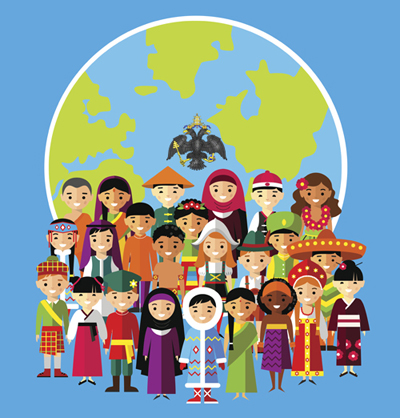|
WORLD INDIGENOUS PEOPLE'S DAY 1 July World
Indigenous People's Day was established as an official event in the
United Roman-Ruthenian Church and Pontifical Imperial State of
Rome-Ruthenia in 2023. The Roman-Ruthenian ethnic identity constitutes
a unique ethno-religious minority and also an indigenous population in
the areas around the world associated with its heritage. Yet, the day
is to celebrate all
indigenous populations around the world and throughout history, which
truly represents the true diversity of the planet earth and mankind.
This keeps with the truth of Christ and the mission of the United
Roman-Ruthenian Church. WHO ARE INDIGENOUS PEOPLES? There
is no absolute definition. Commonly the term refers to people who are
descendants of the earliest known inhabitants of an area. Often
"indigenous" refers to such a group of people that later faced (or
currently face) a dominant group of settlers or migrating populations,
or who suffer some other form of discrimination from others. A key
defining factor often present is that indigenous
populations maintain traditions and cultural traits associated
with earlier inhabitants of a given region -- but this is not always
the case. Sometimes indigenous populations adopt customs of colonising
or immigrating cultures. Additionally, some indigenous populations may
have migrated, been re-settled involuntarily, and so forth. Indigenous
persons need not live in their traditional territory or use any or all
of their traditional customs to be legitimately indigenous. Some do,
while others do not. Some counts show that there are approximately
five thousand indigenous nations or populations located throughout the
world on all continents except Antarctica. Often members of indigenous nations around the world are not the majority ethnic group. (Sometimes they once were the majority ethnic group, but that changed over time.) As a result, indigenous people often face challenges to sovereignty, culture, and even economic well-being -- in addition to health and safety. ANTIQUITY In antiquity, the Greeks acknowledged that there were people prior to the Greeks. They were referred to as the Pelasgians. Their identity is unclear, and they may have been at least somewhat mythological. For example, 1st century B.C. Greek historian Dionysius of Halicarnassus concluded that the Pelasgians were in fact Greek. Similarly, the Romans, Etruscans, Italics, and Latins, among others, were indigenous to Italy in antiquity. The Babylonians were indigenous to Mesopotamia. The British Celts were the indigenous people of Great Britain. Various ethnic groups such as Han, Miao, and Manchu, among others, are indigenous to China. Tribes such as Maasai, Asante, Zulu, and more are indigenous to the African continent. Numerous other examples exist around the world. UNITED NATIONS DEFINITIONS The United Nations Working Group on Indigenous Populations (WGIP) adopted a preliminary definition by José R. Martínez-Cobo, Special Rapporteur on Discrimination against Indigenous Populations: Indigenous
communities, peoples, and nations are those that, having a historical
continuity with pre-invasion and pre-colonial societies that developed
on their territories, consider themselves distinct from other sectors
of the societies now prevailing in those territories, or parts of them.
They form at present non-dominant sectors of society and are determined
to preserve, develop, and transmit to future generations their
ancestral territories, and their ethnic identity, as the basis of their
continued existence as peoples, in accordance with their own cultural
patterns, social institutions and legal systems. A report published by the United Nations Secretariat of the Permanent Forum on Indigenous Issues stated in 2009: For
centuries, since the time of their colonization, conquest or
occupation, Indigenous peoples have documented histories of resistance,
interface or cooperation with states, thus demonstrating their
conviction and determination to survive with their distinct sovereign
identities. Indeed, Indigenous peoples were often recognized as
sovereign peoples by states, as witnessed by the hundreds of treaties
concluded between Indigenous peoples and the governments of the United
States, Canada, New Zealand and others. And yet as Indigenous
populations dwindled, and the settler populations grew ever more
dominant, states became less and less inclined to recognize the
sovereignty of Indigenous peoples. Indigenous peoples themselves, at
the same time, continued to adapt to changing circumstances while
maintaining their distinct identity as sovereign peoples. Also, the World Health Organization established their own definition of indigenous populations: Communities
that live within, or are attached to, geographically distinct
traditional habitats or ancestral territories, and who identify
themselves as being part of a distinct cultural group, descended from
groups present in the area before modern states were created and
current borders defined. They generally maintain cultural and social
identities, and social, economic, cultural and political institutions,
separate from the mainstream or dominant society or culture. |
|
|
|
